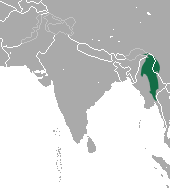Eastern hoolock gibbon
| Eastern Hoolock Gibbon | |
|---|---|
| Scientific classification | |
| Kingdom: | Animalia |
| Phylum: | Chordata |
| Class: | Mammalia |
| Order: | Primates |
| Family: | Hylobatidae |
| Genus: | Hoolock |
| Species: | H. leuconedys |
| Binomial name | |
| Hoolock leuconedys (Groves, 1967) | |
 | |
| Eastern hoolock gibbon range | |
The eastern hoolock gibbon (Hoolock leuconedys) is a primate from the gibbon family, Hylobatidae. It is one of two species of hoolock gibbon. This species is found in extreme eastern corner of Assam and parts of Arunachal Pradesh, Myanmar east of the Chindwin River, such as the Mahamyaing Wildlife Sanctuary, and in south west Yunnan of China.[2] The other hoolock gibbon, the western hoolock (H. hoolock), occurs farther to the west. Indian records for the eastern species may actually represent the western hoolock.[1]
Classification
Mootnick and Groves[3] stated that hoolock gibbons do not belong in the genus Bunopithecus, and placed them in a new genus, Hoolock. This genus was argued to contain two distinct species which were previously thought to be subspecies: Hoolock hoolock and Hoolock leuconedys.[4] The ranges of the two species are unclear and may overlap, and intermediates may occur.[1]
Habitat and Ecology
The eastern gibbon is a forest dwelling primate and prefers a continuous canopy, which makes them vulnerable to loss of habitat and can be found in deciduous or evergreen forests.[1] They also reside in partially deciduous hill forests as well as broadleaf pine forests and can be found as high as 2,700m in elevation in northeastern Myanmar.[1] The gibbon has been found in tropical environments that experience monsoon rains and have cool, dry winters as well as lowland tropical environments.[5][6]
The gibbon is an omnivorous animal with fruits making up the majority of its diet at about 65% with 60% of the fruits being figs.[5] They will also consume lichen, invertebrates, bird eggs, plant parts (buds, shoots, leaves), insects, and flowers.[5] The majority of what they will eat depends on their location and the density of the available resources, but fruits always show to be the most dominant food type this species prefers.[5] Gibbon groups sleep in trees that are close to each other, focusing on the tallest canopy trees, and tend to choose areas that are located either on hilltops or slopes.[5]They will also sleep in a fetal position with their arms hugging their knees into their chests.[5] The gibbons are more active in the summer months, awaking earlier in the day than in the winter months, and socialize more with each other while being awake for about 8-10 hours a day, sleeping shortly before dusk arrives.[5] They will have food competition with Malayan giant squirrels and will chase them away from their food resources but are subject to attacks by thrushes, magpies, and drongos with the drongos being the most aggressive over food.[5]
Threats
The primary threat facing this species is habitat loss and degradation due to human activities such as logging, mining, construction, and agriculture.[5] They have also suffered the effects of being harvested for meat by ethnic groups in India and for use in folk medicine.[5] In Myanmar, the major threat stems from the effects of commercial logging and are subject to competition with humans for resources within the Hukaung Valley Tiger Reserve.[1] Infant gibbons have been known to have been preyed upon by monitor lizards (Varanus) as well as Mountain Hawk Eagles (Nisaetus nipalensis), and larger gibbons have been killed by domestic dogs from local villages while crossing gaps between forests.[6] They are also subject to predation by leopards, pythons, and vultures.[5]
Conservation Efforts
So far, China has created the Gaoligongshan and Tongbiguan National Nature Reserves that currently house small populations of the eastern hoolock gibbon, and the Mahamyaing Sanctuary in Myanmar also acts as a gibbon shelter as well as the Hukaung Valley Tiger Reserve, which has noted that some gibbons live within its boundaries.[1] Within Arunachal Pradesh, the Forest Department has been working with the Wildlife Trust of India (WTI) to transfer gibbon groups to the Mehao Wildlife Sanctuary, and the Biological Park of Itanagar has created a program to captive-breed this species and release them into the wild with the collaboration of the Central Zoo Authority.[1]
References
- 1 2 3 4 5 6 7 8 Brockelman, W.; Geissmann, T. (2008). "Hoolock leuconedys". IUCN Red List of Threatened Species. IUCN. 2008: e.T39877A10278832. doi:10.2305/IUCN.UK.2008.RLTS.T39877A10278832.en. Retrieved 27 August 2016.
- ↑ Groves, C. P. (1967). "Geographic variation in the hoolock or white-browed gibbon (Hylobates hoolock harlan 1834)". Folia Primatologica. 7: 276–283. doi:10.1159/000155125. PMID 5626313.
- ↑ Mootnick, A. R. and C. P. Groves (2005). "A new generic name for the hoolock gibbon (Hylobatidae)". Int. J. Primatol. 26: 971–976. doi:10.1007/s10764-005-5332-4.
- ↑ Mootnick, A. R. (2006). "Gibbon (Hylobatidae) species identification recommended for rescue or breeding centers". Primate Conserv. 21: 103–138. doi:10.1896/0898-6207.21.1.103.
- 1 2 3 4 5 6 7 8 9 10 11 Gron KJ. 2008 August 13. Primate Factsheets: Hoolock gibbon (Hoolock) Conservation . <http://pin.primate.wisc.edu/factsheets/entry/hoolock_gibbon/cons>. Accessed 2016 November 14.
- 1 2 Kumar, Awadhesh; Sarma, Kuladip; Krishna, Murali; Devi, Ashalata (2013). "The Eastern Hoolock Gibbon (Hoolock leuconedys) in Eastern Arunachal Pradesh, India". Conservation International. Retrieved November 20, 2016.
| Wikispecies has information related to: Hoolock leuconedys |
